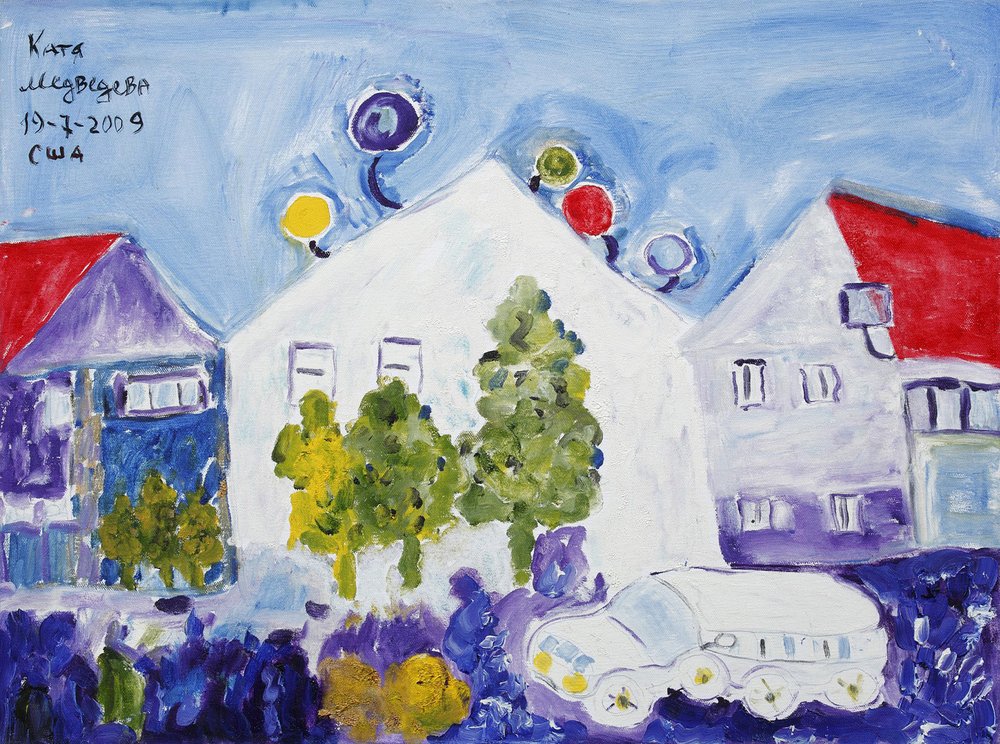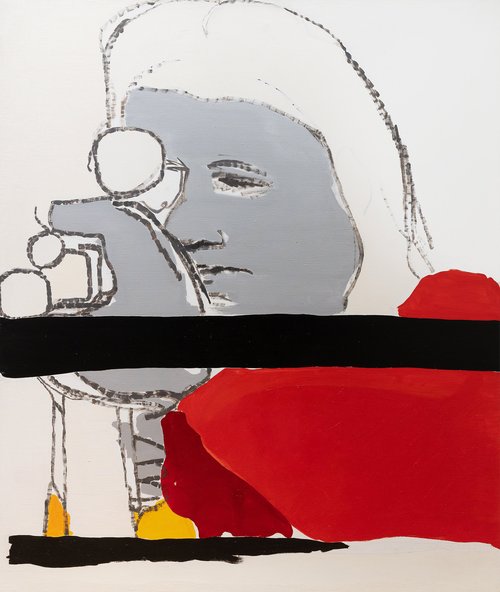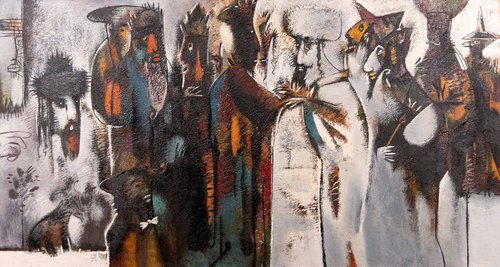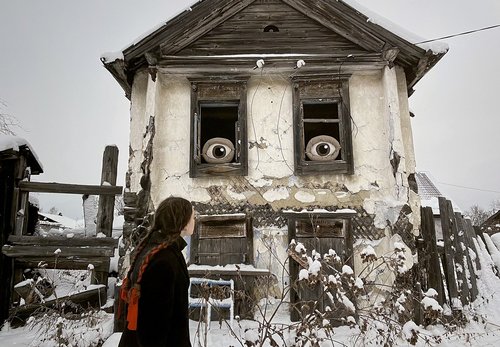New Appreciation for Two Female Artists Konysheva and Medvedeva

Katya Medvedeva. USA, 2009. Courtesy of the artist
The work of two female Russian artists born in the 1930s is becoming ever more sought after on the domestic art market in Moscow. Both women had exceptionally charismatic personalities and were very prolific. Natta Konysheva passed away three years ago and Katya Medvedeva, a legend of naive art, is today 88 years old. Art critic Maria Moskvicheva writes about their respective careers and the growth in interest in their works in an article for The Art Newspaper Russia.
Both Natta Konysheva (1935–2022) and Katya Medvedeva (b. 1937) had very different lives, education and artistic approach yet nevertheless share something in common: the ability to observe and keenly perceive their surroundings, creating art with a natural ease. Nearly the same age, both have left an enormous body of work – about 10,000 paintings each – and both had exceptionally charismatic personalities. Prices for their works are still affordable but are rising with each exhibition – and there are many. The legacy of both women is managed by artist, art historian, curator and gallerist Tatyana Krol, who spoke with The Art Newspaper Russia.
Natta always wore a cap, tracksuit bottoms under a skirt, a plimsoll on one foot, a trainer on the other. Wherever she went, an exhibition opening in a museum or gathering in an apartment, the ballet or a rock concert, she always drew on any scraps of paper that came to hand. This small, thin woman captivated with her self-sufficiency and independence.
Natta Konysheva was born in 1935 in Moscow. She studied at the Moscow Polygraphic Institute, specializing in works on paper under Vladimir Favorsky (1886–1964), a leading master of Russian engraving and book art. In the 1960s and 1970s, she worked in industrial graphic design. She also illustrated and designed various publications. Her acquaintance with Ely Belyutin (1925–2012) became a landmark: in the 1960s, she attended his studio ‘New Reality,’ which expanded her own understanding of the broad horizons of art. If Konysheva adopted the constructive linearity of drawing from Favorsky, then from Belyutin she inherited a deep sense of freedom as an artist. The greatest influence on her, however, came from Dmitry Gordeev (1940–2011), who was part of the ‘Twenty Moscow Artists’ group and they were friends for many years. Her special creative method, which the artist dubbed “reportage painting with elements of miracles,” was something that they had developed together with one major difference: Gordeev’s painting remained always within the framework of nature whereas Konysheva always brought something incredible to her art. From her paintings, one could write a history of the Moscow art scene of recent decades – so many specific people among the characters: artists, gallerists, art critics.
“Natta’s art is immune to market trends; it is fascinated with special pictorial symbols. It is unpretentious, sharp and engaging. Her caricature manner of special social causticity, philosophy, and humour is unique, at first glance her pictures are hard to comprehend. Her style is a synthesis of documentary realism and fantastic expressionism, mixed with surrealism and primitivism,” says Tatyana Krol, whom Natta Konysheva called her muse and drew many times. She has organized a series of posthumous exhibitions of the artist and is currently the only researcher of her work.
In March 2024, the State Institute of Art Studies hosted Konysheva’s solo exhibition ‘Illustration of a Fleeting Era.’ A year later, the Na Shabolovke Gallery in Moscow showed ‘Reportage with Elements of Miracles,’ timed to coincide with the artist's 90th birthday with hundreds of sheets with sketches. After Konysheva's death, tens of thousands of drawings remained, which have yet to be sorted and catalogued. She was extremely prolific painting more than 10,000 canvases. She gave many away, sold others for symbolic sums, but literally in batches. In the Soviet years, with an average salary of 80–300 roubles, a Konysheva painting could be bought for 30 roubles. Many people could afford them.
The artist had a huge studio from the Moscow Union of Artists in Serebryanichesky Lane, a place with over a dozen rooms over two floors crammed with paintings, installations, and all sorts of bric-a-brac from flea markets like masks, figurines of ballerinas, and nutcrackers. The place had a magnetic force – collectors from abroad and engineers, people from very different social strata all visited it. The circle of her admirers is today very large and her works can be found in many Moscow collections. Some are in the collection of the State Russian Museum and the State Tretyakov Gallery. Twice she exhibited in France during her lifetime, in 1988 and 1994. At that time, the French Slavic scholar and collector René Guerra showed her “wonderful reportages” in Nice alongside works by Marc Chagall (1887–1985), Henri Matisse (1869–1954), and Katya Medvedeva (b. 1937). Over 60 years, the artist created tens of thousands of paintings and numerous drawings. Who manages her legacy? Where is it stored?
“I have been working with Natta Konysheva’s legacy after she passed away in 2022, collaborating with her son and heir Kirill Garnisovn and with collectors,” says Tatyana Krol. “Kirill has more than 400 works of various formats. Konysheva created an enormous number of works, but not all are finished; many remained as sketches. There are not many large format, fully completed multi-figure canvases by her in Russia. There is an excellent collection of paintings in France with René Guerra. The Tretyakov Gallery has fifteen paintings, twelve of them from Leonid Talochkin’s collection. There are also works in the Russian Museum and in the Moscow Museum of Modern Art. In Moscow, the most significant collection belongs to Sergei Trofimenko: almost three hundred paintings, including early ones, and hundreds of drawings. It was inherited by him. There is a good collection in Moscow’s Artstory contemporary art gallery and in several museums across Russia, France, and in private and corporate collections around the world. Zurab Konstantinovich Tsereteli offered to stage a solo show in his gallery on Prechistenka, but Natta refused under various pretexts.”
Whether there has been an increase in prices for the artist’s works since she passed away (in the last years of her life, medium-sized works sold for about 150,000 roubles or about 2,000 U.S. dollars), Tatyana Krol says: “We have a sturdy exhibitions strategy and prices for Natta Konysheva are rising. Especially for her largest and highly finished genre canvases which today cost around 3 million roubles (about 37,500 U.S. dollars). Natta Konysheva occupies her own, worthy place in the table of ranks of world contemporary art.”
Many years ago, in 1990, at Phillips in London, a metre-sized painting ‘New Year’ was hammered down for 6,700 U.S. dollars. In 2007 and 2013, there were sales in the range of 1,700–3,500 U.S. dollars. Today, Konysheva’s sketches can sell at auction for 25,000–40,000 roubles (300–500 U.S. dollars). But collectors are looking mostly for her early works and prices for those start from 1,000,000 roubles (12,500 U.S. dollars) and are justifiably rising. For her late period finished works can be worth around 150,000–300,000 (1,900–3,800 U.S. dollars). However, in agreement with Tatyana Krol, Russian auctioneers are confident that the artist has great potential on the art market. Each exhibition attracts new followers, developing interest in her personality and creative output.
Her contemporary 88-year-old Katya Medvedeva, who unlike Natta Konysheva, did not receive an art education has a very different approach but her role in the art scene is similar. This legend of naive art has had a difficult life. She was born in 1937 in the village of Golubino in the Kursk region of Russia. Her prosperous peasant family was dispossessed; her father disappeared at the front; her mother died in 1946. Nine-year-old Katya was sent to an orphanage. She began painting pictures at the age of 40 while working as a cleaner in an art school. Since then, like Natta Konysheva, she has painted some 10,000 canvases, often creating several paintings in a single day. Yet she has never had a studio. She paints in her bedroom in a three-room apartment, where she used to live with her daughter and grandson, and now with an assistant, a friend of her now-deceased daughter. Today, Katya Medvedeva is not as creatively active as before but continues to paint with acrylics on fabric or canvas.
“As with Natta Konysheva, I discovered Katya Medvedeva through my work at the M'ARS Contemporary Art Centre in Moscow, where I was working on various exhibition projects,” says Tatyana Krol. “In 2005, we had an exhibition ‘Bolshoi Theatre: Journey Through the Looking Glass,’ where Katya Medvedeva's works were exhibited together with photographs by Sasha Manovtseva. Whenever you come across an interesting artist, you cannot help but stop and look more closely at their art. Katya Medvedeva is an exceptionally lively artist. The first exhibition I curated of her work was in 2010 at the Slovak Institute in Moscow. The show included fifty paintings – there were ballerinas, angels, saints with sad eyes, Pushkin, Gogol, Esenin, sunflowers, village landscapes all painted on canvases, on velvet, on brocade, with feathers, lace and sequins, and on patterned shiny fabric, made as if for church vestments. Often, she glued beads and colourful sequins onto the canvases, they were so imaginative and left a strong impression. The artist wearing an extravagant costume, in boots hand-painted with heavenly flowers was herself an extraordinary exhibit at the opening reception of the show. Katya Medvedeva seems to be the last living legend of naive art.”
Katya Medvedeva’s painting is distinguished by its improvisational character, almost childlike perspective, romantic expression, and breadth of thinking. In March this year, a major exhibition of her work from Moscow collections was held at the State Institute of Art Studies. In 2023, an exhibition from private collections, ‘The Quiet Life of Beauty,’ opened in Ryazan. And in 2022, at the All-Russian Museum of Decorative Art, a personal project ‘The Universe of Katya Medvedeva’ took place, after a decade-long pause.
The door to Medvedeva’s artistic universe was opened by Norbert Kuchinka, who worked as a journalist in Moscow for many years. He immediately acquired a significant number of works and exhibited them in his homeland, Germany. Medvedeva’s works are in the collection of the Museum of Naive Art in Nice, the All-Russian Museum of Decorative Art, the Vladimir-Suzdal Museum-Reserve (which has a large collection of naive art), and the Tsaritsyno State Museum-Reserve.
Katya Medvedeva, like Natta Konysheva, used to give her works away for nothing or sold them for symbolic prices like 20,000–50,000 roubles (about 700–1,700 U.S. dollars at the rate of the time) in the 2000s. Today, galleries sell her early paintings for more significant amounts – from 200,000 roubles (2,500 U.S. dollars). So far, prices for the artist’s works have not exceeded 500,000 roubles (6,250 U.S. dollars); however, with each new exhibition, the circle of gallerists, art critics, and collectors interested in her work is expanding.
This article was first published in Russian in the May 2025 issue of The Art Newspaper Russia.


















